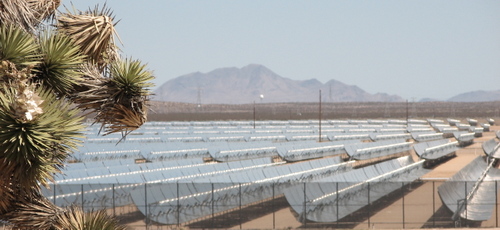PG&E Signs World's Largest Solar Power Deal
 photo: green wombat
photo: green wombatCalifornia utility PG&E today will announce an agreement to buy 553 megawatts of electricity from a solar power plant to be built by Israeli company Solel in the Mojave Desert. That's enough energy to light about 400,000 homes. It's the largest deal of its kind, just edging out Southern California Edison's (EIX) 2005 agreement to purchase 500 megawatts of solar electricity from a power plant to be built by Stirling Energy Systems in the Mojave. Solel's 6,000-acre Mojave Solar Park is set to begin operating in 2011. The Solel station will be located near nine existing solar power plants built in the 1980s by Israeli company Luz (photo above) that continue to supply 354 megawatts of green energy to Southern California. It's an appropriate locale. When Luz went bankrupt in the early '90s after solar energy tax breaks evaporated and natural gas prices fell, Solel picked up the company's parabolic trough technology. (Luz, meanwhile, has been revived as BrightSource Energy, which is negotiating a 500-megawatt deal with PG&E.) Solel will use a more advanced version of the solar trough for its Mojave project, which will contain 1.2 million mirrors and 317 miles of vacuum tubing. Just this week the company announced that it had upgraded the old Luz plants - most of which are now operated by FPL Energy (FPL) - with 30,000 new solar receivers.
Solar trough power plants use parabolic mirrors to track the sun and heat tubes of liquid to produce steam that drives electricity-generating turbines. The efficiency of solar troughs is quite a bit lower than other utility-scale technologies under development, but it's tried and true and that's what apparently attracted PG&E (PCG), which emphasized it was "commercially-proven." The San Francisco-based utility has been hedging its bets, signing deals with companies developing a variety of solar technologies. BrightSource Energy, for instance, will deploy fields of mirrors to focus the sun's rays on a tower containing a water-filled boiler to create steam to drive a turbine. PG&E has also signed a deal with San Francisco solar startup GreenVolts to build a two-megawatt "plug-in" power plant that will use concentrating photovoltaic technology to produce electricity near urban areas.
PG&E's deal with Solel is another sign that California has become a proving ground for Big Solar technologies. Stirling Energy Systems uses a giant solar dish to concentrate the sun's rays on a Stirling heat engine. As hydrogen inside the engine expands it drives pistons that generate electricity. The Stirling dish is far more efficient than the solar trough but it has never been deployed on a large scale. Stirling Energy's deals with Southern California Edison and San Diego Gas & Electric (SRE) have options to produce up to 1.75 gigawatts of solar electricity. Add in the Solel 25-year contract and - assuming PG&E reaches a final deal with BrightSource Energy - California potentially could have nearly three gigawatts of utility-scale solar power online within the next five or six years.